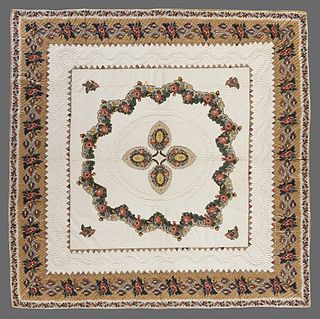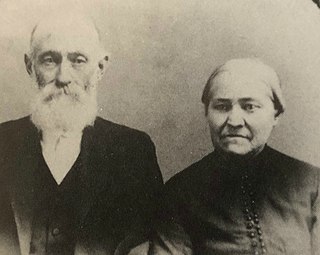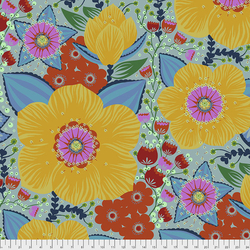Barbara Brackman (born July 6, 1945) is a quilter, quilt historian and author. [1]
Barbara has written numerous books on quilting during the Civil War including Facts & Fabrications: Unraveling the History of Quilts and Slavery, Barbara Brackman's Civil War Sampler, Barbara Brackman's Encyclopedia of Appliqué, America's Printed Fabrics 1770-1890, Civil War Women, Clues in the Calico, Emporia Rose Appliqué Quilts, Making History–Quilts & Fabric from 1890-1970, and Quilts from the Civil War, all published by C&T Publishing . Her Encyclopedia of Pieced Quilt Patterns contains more than 4000 pieced quilt patterns, derived from printed sources published between 1830 and 1970. [2]
She was inducted into the Quilters Hall of Fame of Marion, Indiana in 2001. [3] [4]

Quilting is the term given to the process of joining a minimum of three layers of fabric together either through stitching manually using a needle and thread, or mechanically with a sewing machine or specialised longarm quilting system. An array of stitches is passed through all layers of the fabric to create a three-dimensional padded surface. The three layers are typically referred to as the top fabric or quilt top, batting or insulating material, and the backing.

Patchwork or "pieced work" is a form of needlework that involves sewing together pieces of fabric into a larger design. The larger design is usually based on repeating patterns built up with different fabric shapes. These shapes are carefully measured and cut, basic geometric shapes making them easy to piece together.

A quilt is a multi-layered textile, traditionally composed of two or more layers of fabric or fiber. Commonly three layers are used with a filler material. These layers traditionally include a woven cloth top, a layer of batting or wadding, and a woven back combined using the techniques of quilting. This is the process of sewing on the face of the fabric, and not just the edges, to combine the three layers together to reinforce the material. Stitching patterns can be a decorative element. A single piece of fabric can be used for the top of a quilt, but in many cases the top is created from smaller fabric pieces joined, or patchwork. The pattern and color of these pieces creates the design.

Sashiko is a type of traditional Japanese embroidery or stitching used for the decorative and/or functional reinforcement of cloth and clothing. Owing to the relatively cheap nature of white cotton thread and the abundant nature of cheap, indigo-dyed blue cloth in historical Japan, sashiko has a distinctive appearance of white-on-blue embroidery, though some decorative pieces may also use red thread.

Appliqué is ornamental needlework in which pieces or patches of fabric in different shapes and patterns are sewn or stuck onto a larger piece to form a picture or pattern. It is commonly used as decoration, especially on garments. The technique is accomplished either by hand stitching or machine. Appliqué is commonly practised with textiles, but the term may be applied to similar techniques used on different materials. In the context of ceramics, for example, an appliqué is a separate piece of clay added to the primary work, generally for the purpose of decoration.

Broderie perse is a style of appliqué which uses printed motifs from one fabric to create a design on a background fabric. It was popular in the late 18th century and early 19th centuries. The technique could be considered an early form of puzzle piecing.

Chintz is a woodblock printed, painted, stained or glazed calico textile that originated in Golconda in the 16th century. The cloth is printed with designs featuring flowers and other patterns in different colours, typically on a light, plain background.

Baltimore album quilts originated in Baltimore, Maryland, in the 1840s. They have become one of the most popular styles of quilts and are still made today. These quilts are made up of a number of squares called blocks. Each block has been appliquéd with a different design. The designs are often floral, but many other motifs are also used, such as eagles and landmarks. They have a background of white and incorporate many primary colors such as reds, greens and blues.

The history of quilting, the stitching together of layers of padding and fabric, may date back as far as 3400 BCE. For much of its history, quilting was primarily a practical technique to provide physical protection and insulation. However, decorative elements were often also present, and many quilts are now primarily art pieces.

Textile geometry is the creative and technical process by which thread or yarn fibers are woven together or interlaced to form a flexible, functional, and decorative cloth or fabric which is subsequently printed upon or otherwise adorned. Textile design is further broken down into three major disciplines: printed textile design, woven textile design, and mixed media textile design, each of which use different methods to produce a surface ornamented fabric for variable uses and markets. Textile Design as a practice has evolved to become an industry integral to other disciplines such as fashion, interior design, and fine arts.
Marie Daugherty Webster was a quilt designer, quilt producer, and businesswoman, as well as a lecturer and author of Quilts, Their Story, and How to Make Them (1915), the first American book about the history of quilting, reprinted many times since. She also ran the Practical Patchwork Company, a quilt pattern-making business from her home in Wabash, Indiana, for more than thirty years. Webster's appliquéd quilts influenced modern quilting designs of the early twentieth century. Her quilts have been featured in museums and gallery exhibition in the United States and Japan. The Indianapolis Museum of Art holds the largest collection of her quilts in the United States. Webster was inducted into the Quilters Hall of Fame in 1991. The Marie Webster House, her former residence in Marion, Indiana, was listed on the National Register of Historic Places in 1992, was designated a National Historic Landmark in 1993, and serves as the present-day home of the Quilters Hall of Fame.
Quilts of the Underground Railroad describes a controversial belief that quilts were used to communicate information to African slaves about how to escape to freedom via the Underground Railroad. It has been disputed by a number of historians.
Mimi Dietrich is an American quilter, quilting instructor, author of 17 books about quilting and a member of the Quilter's Hall of Fame. A lifelong resident of Maryland, she lives in the Baltimore County community of Catonsville. Her first book, Happy Endings: Finishing the Edges of Your Quilts, was originally published in 1987. She teaches quilting classes in the Maryland area as well as online at Craftsy. Her books and workshops focus mainly on applique techniques and Baltimore Album Quilts. In total, her books have sold over a half million copies.
Yvonne Porcella was an American art quilter.

Sophie Tatum LaCroix was an American handcrafts designer, editor and author of 18 books on crochet, tatting, beadwork, quilting, needlework and embroidery in the early 1900s.

Jean Ray Laury was an American artist and designer. She was one of the first fine artists to move to quilting as a medium of choice in the late 1950s. Her quilts followed neither traditional method nor pattern; they were bold, modern, colorful collages, often laced with humor and satire. Penning over twenty books and teaching over 2,000 workshops, Laury helped women see the creative possibilities in everyday objects and awake their sense of inspiration. Laury has been called a "foremother of a quilt revival", and "one of the pioneers" of non-traditional quilts.
Hannah Slater was an early American pioneer and inventor. Some sources state that she was the first American woman to receive a patent, however others state that Hazel Irwin, in 1808, or Mary Kies, in 1809, was the first.

Susan McCord was an American quilter. She is best known for her innovative designs and exquisite craftsmanship. Thirteen of McCord's quilts are included in the permanent collection of the Henry Ford Museum in Dearborn, Michigan.

Anna Maria Horner is an artist, author and fabric designer in Nashville, Tennessee, known for her colorful fabric designs, quilts, and sewing patterns. In addition to teaching classes and selling items globally under her namesake brand, she has written several books about sewing, quilting, and needlework. Horner has appeared on The Martha Stewart Show and been featured in Better Homes and Gardens. In May 2015 she opened Craft South, a craft store and studio in Nashville.

Gwen Marston née Gwendolyn Joy Miller was an American quilter, quilt teacher, lecturer, and author who championed a style of quilting she called liberated quiltmaking. She encouraged modern quilt makers to break away from using commercial quilt patterns and to learn to design their own unique pieces of art.